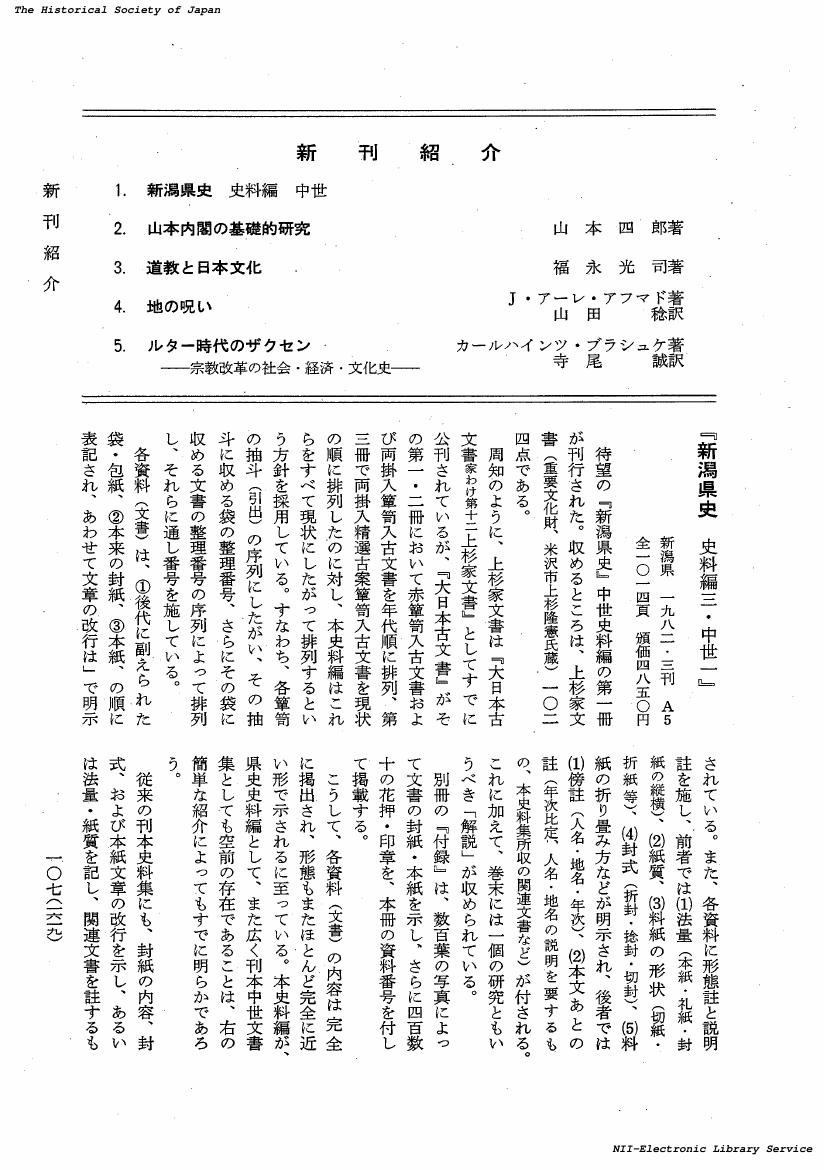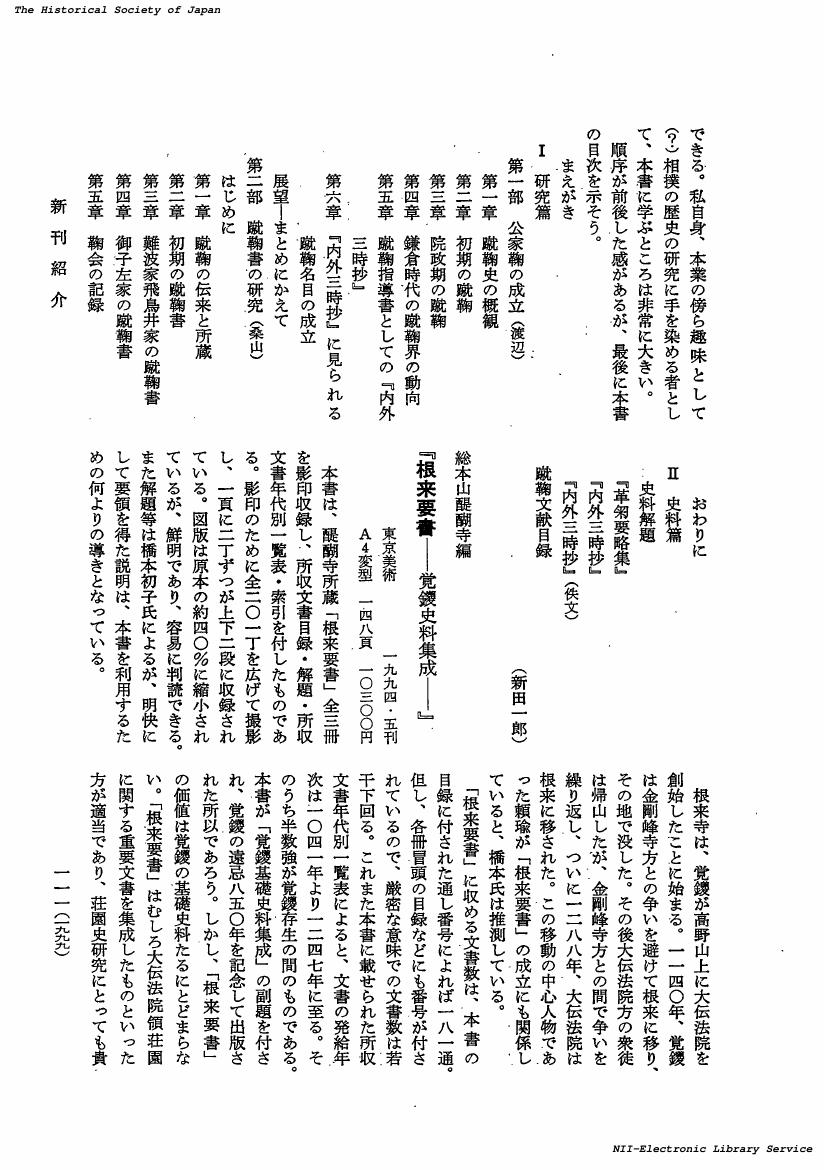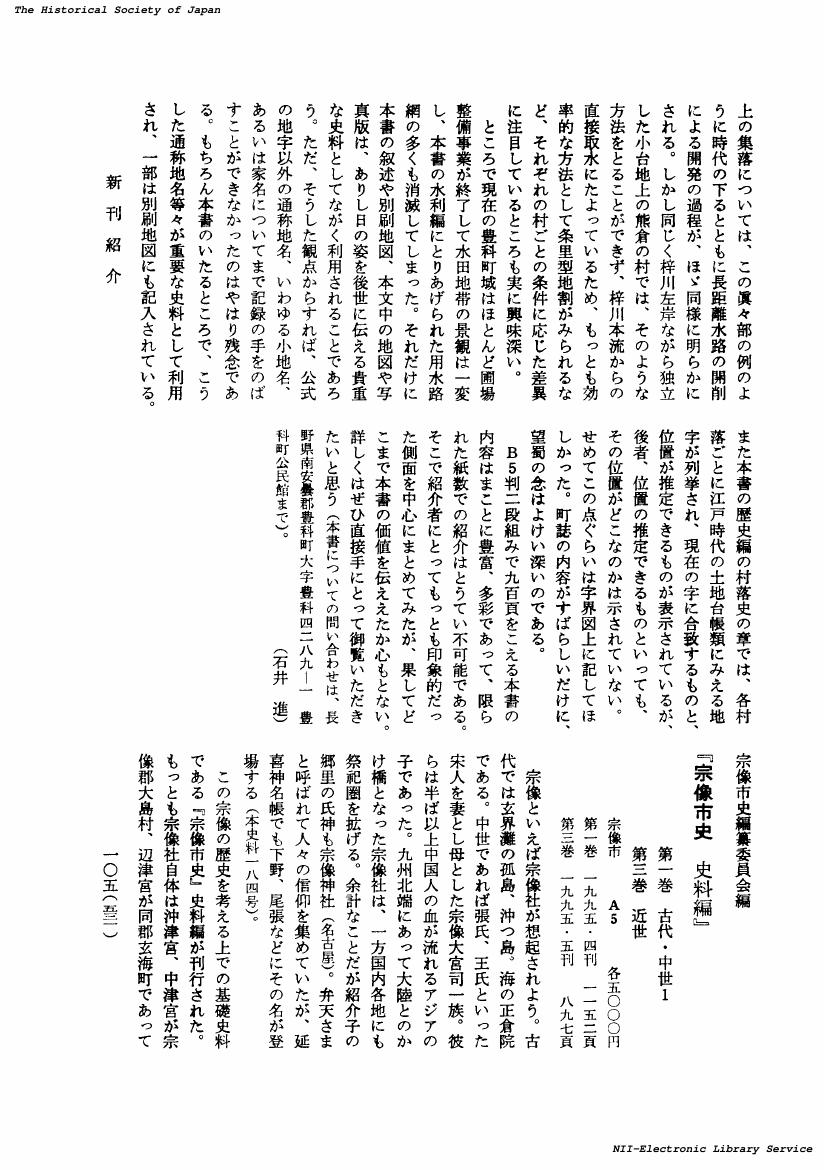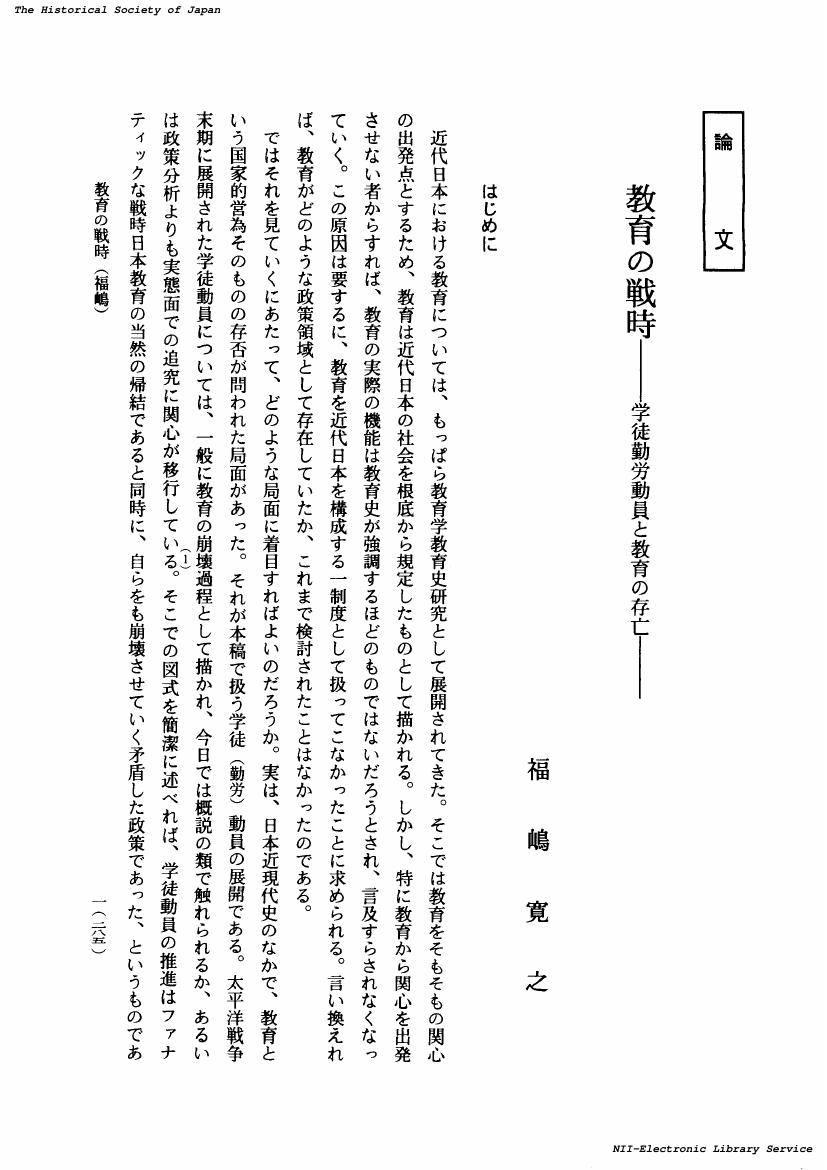5 0 0 0 OA 『新潟県史 史料編三・中世一』, 新潟県, 一九八二・三刊, A5, 全一〇四頁
- 著者
- 小林 清治
- 出版者
- 公益財団法人 史学会
- 雑誌
- 史学雑誌 (ISSN:00182478)
- 巻号頁・発行日
- vol.91, no.10, pp.1619-1620, 1982-10-20 (Released:2017-11-29)
- 著者
- 田中 博美
- 出版者
- 公益財団法人 史学会
- 雑誌
- 史学雑誌 (ISSN:00182478)
- 巻号頁・発行日
- vol.95, no.3, pp.389-390, 1986-03-20 (Released:2017-11-29)
- 著者
- 神田 千里
- 出版者
- 公益財団法人 史学会
- 雑誌
- 史学雑誌 (ISSN:00182478)
- 巻号頁・発行日
- vol.101, no.1, pp.126-127, 1992-01-20 (Released:2017-11-29)
- 著者
- 五味 文彦
- 出版者
- 公益財団法人 史学会
- 雑誌
- 史学雑誌 (ISSN:00182478)
- 巻号頁・発行日
- vol.95, no.7, pp.1237-1239, 1986-07-20 (Released:2017-11-29)
- 著者
- 近藤 成一
- 出版者
- 公益財団法人 史学会
- 雑誌
- 史学雑誌 (ISSN:00182478)
- 巻号頁・発行日
- vol.103, no.11, pp.1999-2000, 1994-11-20 (Released:2017-11-30)
- 著者
- 石井 進
- 出版者
- 公益財団法人 史学会
- 雑誌
- 史学雑誌 (ISSN:00182478)
- 巻号頁・発行日
- vol.96, no.8, pp.1372-1374, 1987-08-20 (Released:2017-11-29)
- 著者
- 石井 進
- 出版者
- 公益財団法人 史学会
- 雑誌
- 史学雑誌 (ISSN:00182478)
- 巻号頁・発行日
- vol.104, no.2, pp.253-254, 1995-02-20 (Released:2017-11-30)
5 0 0 0 OA 宗像市史編纂委員会編『宗像市史, 史料編』第一巻, 古代・中世1, 第三巻, 近世, 宗像市, A5, 各五〇〇〇円, 第一巻, 一九九五・四刊, 一一五二頁, 第3巻, 一九九五・五刊, 八九七頁
- 著者
- 服部 英雄
- 出版者
- 公益財団法人 史学会
- 雑誌
- 史学雑誌 (ISSN:00182478)
- 巻号頁・発行日
- vol.105, no.6, pp.531-533, 1996-06-20 (Released:2017-11-30)
5 0 0 0 復古王政期におけるフランス革命の記憶
- 著者
- 遅塚 忠躬
- 出版者
- 公益財団法人 史学会
- 雑誌
- 史学雑誌 (ISSN:00182478)
- 巻号頁・発行日
- vol.110, no.12, pp.2059-2093, 2001
Article 7 of the "Amnesty Bill of 1816" decreed "regicides" (deputies of the National Convention who had voted for the death of Louis XVI) to be exempted from amnesty, and it condemned the regicides who had joined Napoleon's hundred days to go into exile forever out of the French kingdom. However, several regicides continued to live in France (those who had not joined Napoleon, who had been granted a stay of execution, and who had gone underground). The central and local police agencies were very cautious of these regicides living in France, because it was possible that the memories of the Revolution connected with the regicide survivors would be menacing to the Restoration monarchy. The authorities were so cautious of this dangerous movement that there are many documents about it in the dossiers of the Ministery of Police. This paper aims to shed light on some aspects of the memories of the Revolution under the Restoration by investigating these police documents (F7 in the National Archives). The results of the research are as follows. First, the most positive and favourable memories of the Revolution were held, grosso modo, among the peasantry and popular classes, while the most negative and disfavourable ones were held among local rich notables. Secondly, this social distinction of memories having been complicated according to local situations, frictions between positive and negative memories took place in various forms. Thirdly, among the peasantry and popular classes, positive memories of the Revolution were maintained in the same formula (the Revolution which had abolished feudal dues) throughout the Restoration, while among local notables and bourgeois, memories of the Revolution tended to fade away or be forgotten in the early days of the Restoration. Finally, if we look ahead into the second half of the19th century, the succession of memories of the Revolution would not be so straightforward. That is to say, memories of the Revolution would be transformed, resurrected and, at the same time, forged or invented, up to the Third Republic.
- 著者
- 大島 明子
- 出版者
- 公益財団法人 史学会
- 雑誌
- 史学雑誌 (ISSN:00182478)
- 巻号頁・発行日
- vol.117, no.7, pp.1219-1252, 2008
In the research to date on government-military relations regarding the Japanese Army, emphasis has been put mainly on the relationship between party cabinets and the military high command. However, during the period between the establishment of a prefectural system to replace Tokugawa period feudal domains and the setting up of an independent general staff office (i.e., during the formation of Japan's modern armed forces), the Army consisted of groups affiliated to the feudal domains, resulting in ambiguity concerning the chain of command. Moreover, in the midst of clear divisions between civilian politicians manning the Cabinet (Sei'in 正院) and military personnel, opinions were divided over how a modern army should be formed; add in the political struggle brewing over the Treasury's jurisdiction over local entities, and there was an eminent danger of the Army disintegrating into smaller factions. Within this situation, the Ministry of the Army was granted broad powers, including control over personnel and military command, and enjoyed relative autonomy from the Cabinet in forming a modern army. However, from 1872-73, during which time the Imperial Guard was reorganized from troops sent by three powerful feudal domains to soldiers from divers regions, a plan was advanced by officers affiliated with Satsuma Domain and Minister of Foreign Affairs Soejima Taneomi 副島種臣 to invade Taiwan, and the Cabinet followed suit with plans of its own to recruit former feudal domain troops to form an expeditionary force. This article interprets these events as a political struggle between the Cabinet and the Ministry of the Army over military authority, and focuses on the participation of the Cabinet's Legislative Bureau (Sa'in 左院) at a time when it was aiming at both the abolition of the feudal status system and constitutional reform. The Legislative Bureau spontaneously cooperated in establishing a military conscription act and approached Tosa Domain with a plan for a "parliamentary body" that would deliberate on military affairs. An examination of this political process makes it possible to reinterpret political-military relations at that time in terms of a triangle involving the Cabinet, the Ministry of the Army and the Legislative Bureau (along with its regional administrators). What ultimately happened was that in June or July of 1873, a group led by councillor (sangi) Itagaki Taisuke of Tosa Domain halted the Legislative Bureau's attempts at constitutional reform by introducing a proposal to invade Korea, which led to political gridlock and the resignation of the invasion supporters in October. This incident should therefore be considered on two levels: constitutional reform vs. centralization of Cabinet power, and the struggle between the Ministry of the Army and the Cabinet over command of the military.
5 0 0 0 OA 教育の戦時 : 学徒勤労動員と教育の存亡
- 著者
- 福嶋 寛之
- 出版者
- 公益財団法人 史学会
- 雑誌
- 史学雑誌 (ISSN:00182478)
- 巻号頁・発行日
- vol.114, no.3, pp.285-318, 2005-03-20 (Released:2017-12-01)
5 0 0 0 OA 豊臣政権の算用体制
- 著者
- 谷 徹也
- 出版者
- 公益財団法人 史学会
- 雑誌
- 史学雑誌 (ISSN:00182478)
- 巻号頁・発行日
- vol.123, no.12, pp.2125-2148, 2014-12-20 (Released:2017-07-31)
The large body of research literature that has accumulated to date on the direct landholdings (kurairi-chi 蔵入地) of the Toyotomi Hideyoshi regime, which formed its power base, has run the gamut from identifying the locations of those holdings to the role they played in funding Hideyoshi's military forays into the Korean Peninsula. The present article attempts to reexamine this research by focusing on the means by which the regime's leaders who administered kurairi-chi went about settling accounts related to it, and in so doing describe in substantive terms such aspects as the regime's internal structure and the remission of rice (kuramai 蔵米) harvested from its landholdings. The author begins with a review of the various fiscal documents related to kurairi-chi; namely, kirifu 切符, uketori-jo 請取状 and kaisai-jo 皆済状 Kirifu was a document drawn up to indicate how kuramai was to be used, addressed to the manager of a kurairi-chi holding and specifying to whom the rice was to be allotted, while uketori-jo was a certificate of receipt for rice remitted to the regime in the form of cash. Kaisai-jo, which was issued in the settlement of accounts and whose function was assumed in 1590 by the sanyo-jo 算用状, recorded the information contained in the kirifu (allotment) and uketori-jo (receipt) related to any transaction. From these documents and the parts of them written directly by Hideyoshi himself, the author concludes that it was Hideyoshi who held the ultimate authority over the regime's expenditures of rice and cash, as well as the determination of tax exemptions (rates) on kurairi-chi holdings, while his functionaries were charged only with settling related accounts. Next the author turns to changes that occurred in the personnel handling the settlement of accounts, beginning with Ito Yozaemon, a Toyotomi retainer with a commercial background, but later reverting to regime functionaries, called Sanyo Bugyo 算用奉行. The staff first consisted of two members, Nakatsuka Masaie and Mashita Nagamori, to whom Asano Nagayoshi and Maeda Gen'i were added. A document dating back to Asano's removal from office in 1595 verifies the office of Sanyo Bugyo as an important administrative group within the regime. Later Ishida Mitsunari would join the staff, then after Hideyoshi's death, the office's duties were incorporated into the Go-bugyo 五奉行 (Five Deputies) system. Finally, following the Battle of Sekigahara, Katagiri Katsumoto and Koide Hidemasa took over the settlement of accounts. Most of the revenue received from kurairi-chi was spent locally, while the portion remitted to the central government was transferred in gold and silver. However, the kurairi-chi managers were almost always late in their submission of copies of tax exemption (rate) lists (men-mokuroku 免目録) and sanyo-jo, to the extent of being fined by the regime for negligence. In light of such a situation, the author concludes that despite the fact that a system of account settlement was firmly put in place within the Toyotomi administrative bureaucracy, the regime was still not able to gain complete managerial control over its kurairi-chi.
- 著者
- 井ノ口 哲也
- 出版者
- 公益財団法人 史学会
- 雑誌
- 史学雑誌 (ISSN:00182478)
- 巻号頁・発行日
- vol.120, no.9, pp.1569-1577, 2011-09-20 (Released:2017-12-01)
5 0 0 0 ビザンツ皇帝レオン六世の対アルメニア人有力者政策
- 著者
- 仲田 公輔
- 出版者
- 公益財団法人 史学会
- 雑誌
- 史学雑誌 (ISSN:00182478)
- 巻号頁・発行日
- vol.125, no.7, pp.40-63, 2016
ビザンツ皇帝レオン6世(在位886-912)は、帝国東方のアルメニア人有力者に対して交渉を持ち、彼らを利用して新たな軍管区の設置も行ったとされる。この政策はJenkinsらの従来の研究においては、9-10世紀にかけてのビザンツ帝国の積極的東方進出政策の文脈に位置づけられ、後の大規模な拡大の土台だと解釈されてきた。しかし本稿は、近年のHolmesやShepardが10世紀以降の「再征服」本格化の時期について行った、ビザンツ帝国の東方に対する一貫した戦略の想定を見直す研究に鑑み、その始点とされるレオン6世の政策の意義についても再考を試みる。その際に、従来は十分に議論されてこなかったアルメニア人勢力側の主体性にも着目し、彼らの動向のビザンツの政策への影響についても考察することで、新たに境域での両者の双方向的な関係性の実態の一端を明らかにすることを目指す。<br>そのため本稿では第一に、イスラーム勢力の動向や、アルメニア人有力者間の関係も視野に入れ、レオン6世期のアルメニアの状況・政治構造について整理して考察し、その中でのアルメニアの諸勢力の動向とその背景について議論する。その過程で、アルメニア人勢力側にも主体的にビザンツに働きかけうる状況が存在することも確認できる。第二に編纂物を中心とするギリシア語史料に目を向け、ビザンツ帝国がそのようなアルメニアをどのように位置づけていたのかを再検討する。そして最後にそれらを踏まえた上で、レオン6世期のアルメニア境域政策の個別事例の詳細について再検討し、ビザンツ=アルメニア境域における政治秩序の再編の実態を明らかにする。<br>こうした考察を経ることで、レオン6世の政策からは、ビザンツ帝国側が一貫して主導権を握っていたわけではなく、アルメニアの諸勢力が彼らの側の事情に基づいて帝国側に対して行う様々な働きかけを行い、それに対する反応として帝国側が対策措置を講じていくという、相互交渉の実態が明らかになるのである。
- 著者
- 山田 勅之
- 出版者
- 公益財団法人 史学会
- 雑誌
- 史学雑誌 (ISSN:00182478)
- 巻号頁・発行日
- vol.118, no.7, pp.1330-1356, 2009
During the Ming Period from the Tianshun era (天順) on, the native official surnamed Mu occupied and ruled Tibetan regions, even Yongning in Yunnan and Yanjing in Sichuan which were regarded as native governance by the Ming Dynasty. Many documents record that the native official surnamed Mu acted as "buffer" for the Ming. Almost all earlier studies have pointed that this native official was under the control of the Ming Dynasty on the basis of such documents. This article intends to clarify the military activities of the native official surnamed Mu and how it governed the regions in question after its occupation of them, examine the perceptions and responses to that situation on the part of the Ming Dynasty and the region's Tibetan population, and consider the significance of such foreign expansion. First, concerning the Tibetan response to military activities within their region, the native official surnamed Mu was perceived not only as military rulers, but also guardians of the Karma pa sect of Tibetan Buddhism. Next, concerning military movements in Yongning and Yanjing, after a settlement was reached in 1535, the 14th year of the jiajing era (嘉靖) over territorial disputes among Lijiang, Yongning and Yanjing, the native official surnamed Mu refused to abide by the settlement and proceeded to occupy almost all of Yongning and Yanjing. Meanwhile, the conflict between the Ming Dynasty and the Tibetan regions continued unabated, a situation under which the native official surnamed Mu's invasion can be viewed as matching Tibetan anti-Ming activities, which probably explains the silence concerning his occupation of Yongning and Yanjing. In other words, a reciprocal relationship was established between the native official surnamed Mu and the Chinese world, a relationship that would continue for generations. It was in this way that he achieved political autonomy and displayed its ability to maintain social order throughout the Ming Period.
5 0 0 0 OA 東アジア : 中国 : 現代(一九七六年の歴史学界 : 回顧と展望)
- 著者
- 吉澤 南
- 出版者
- 公益財団法人 史学会
- 雑誌
- 史学雑誌 (ISSN:00182478)
- 巻号頁・発行日
- vol.86, no.5, pp.710-715, 1977-05-20 (Released:2017-10-05)
5 0 0 0 〓公〓の資料的問題について
- 著者
- 竹内 康浩
- 出版者
- 公益財団法人 史学会
- 雑誌
- 史学雑誌 (ISSN:00182478)
- 巻号頁・発行日
- vol.115, no.1, pp.35-53, 2006
Suigongxu is a bronze vessel that has appeared in the research literature as of late and which many scholars believe dates back to the middle of the Western Zhou period. The vessel contains a long inscription of about 100 characters, the content of which has been rendered as unique. In particular, two aspects of the inscription stand out. One is the appearance of a mythological character Yu禹; the other, the use of the term tianxia天下(the world). Neither terms have appeared in the available source materials on the period to date and therefore have been lauded as new insights into Western Zhou thought and culture. However, we do not know the circumstances surrounding the archeological discovery of the vessel, and both its construct and inscription differ greatly from what has been identified to date as "Western Zhou" style bronzeware and prose. Based on such doubts, the author of the present article discusses the content of the vessel's inscription and comes to the conclusion that great caution should be taken in assuming that at face value the vessel will shed new light on the period in question. What has to be debated first is whether it is a genuine Western Zhou period bronze artifact or not.
- 著者
- 岡本 託
- 出版者
- 公益財団法人 史学会
- 雑誌
- 史学雑誌 (ISSN:00182478)
- 巻号頁・発行日
- vol.123, no.8, pp.1497-1521, 2014
This article discusses how high-ranking officials were trained under France's July Monarchy (1830-1848), at a time when government administration was becoming more and more complex and a bureaucratic organization was gradually being institutionalized. The author takes up the case of the Auditorat in the Conseil d'Etat, focusing on the logic behind the recruitment and training of its administrative officials. He describes the actual circumstances of recruitment and training of auditeurs via a synthesis of three approaches: 1) institutional analysis of the auditeur based on laws and ordinances, 2) prosopographical analysis utilizing the personal data of 211 auditeurs and 3) analysis of petitions for recruitment of auditeurs as well as their internal evaluation. The author concludes that first, two contrary opinions existed regarding the institution of auditeur during the time in question. One was the conservative idea which considered the auditorat as a stagiaire who would become merel a maitre des requetes or a conseiller in the Conseil d'Etat in the future; the other was the republican idea which considered the institution to be the grande ecole d'administration, in which trained officials who could be entrusted with any administrative post. The laws and ordinances pertaining to auditeurs promulgated under the July Monarchy all embodied the opposition between these ideologies. Secondly, the necessary conditions of auditeur recruitment were threefold: 1) the social background of the candidate, 2) the influence of recommenders and 3) the abilities of the candidate. However, it is impossible to determine which condition was the most conclusive, leading one to believe that it was a combination of them which led to successful recruitment. Finally, as to the system of auditeur training, the author points out that auditeurs were expected to acquire the skills of administrative officials through experience gained along different career paths, which included a central administrative post, a local administrative post and a post in the Conseil d'Etat. However, auditeur training was not very successful because of the customs surrounding the promotion of central administrative officials and the lack of administrative ability on the part of the auditeurs themselves. In addition, the lack of maitre des requetes posts in the Conseil d'Etat made the training of auditeurs more difficult. Nevertheless, approximately half of those who had trained at the auditorat under the July Monarchy were given administrative appointments and reappointed by the next political regime. This proportion of reappointments exceeded the number during the Napoleonic era and the Bourbon Restoration. Consequently, it can be said that the institution of auditeur under the July Monarchy served the function of training high-ranking officials to some extent and that this institution had a impact on both the struggle for hegemony in the Chambre des pairs and the Chambre des deputes, and on the institutionalization of the recruitment and the careers of high-ranking officials during the nineteenth century.
4 0 0 0 OA 復古王政期におけるフランス革命の記憶
- 著者
- 遅塚 忠躬
- 出版者
- 公益財団法人 史学会
- 雑誌
- 史学雑誌 (ISSN:00182478)
- 巻号頁・発行日
- vol.110, no.12, pp.2059-2093, 2001-12-20 (Released:2017-11-30)
Article 7 of the "Amnesty Bill of 1816" decreed "regicides" (deputies of the National Convention who had voted for the death of Louis XVI) to be exempted from amnesty, and it condemned the regicides who had joined Napoleon's hundred days to go into exile forever out of the French kingdom. However, several regicides continued to live in France (those who had not joined Napoleon, who had been granted a stay of execution, and who had gone underground). The central and local police agencies were very cautious of these regicides living in France, because it was possible that the memories of the Revolution connected with the regicide survivors would be menacing to the Restoration monarchy. The authorities were so cautious of this dangerous movement that there are many documents about it in the dossiers of the Ministery of Police. This paper aims to shed light on some aspects of the memories of the Revolution under the Restoration by investigating these police documents (F7 in the National Archives). The results of the research are as follows. First, the most positive and favourable memories of the Revolution were held, grosso modo, among the peasantry and popular classes, while the most negative and disfavourable ones were held among local rich notables. Secondly, this social distinction of memories having been complicated according to local situations, frictions between positive and negative memories took place in various forms. Thirdly, among the peasantry and popular classes, positive memories of the Revolution were maintained in the same formula (the Revolution which had abolished feudal dues) throughout the Restoration, while among local notables and bourgeois, memories of the Revolution tended to fade away or be forgotten in the early days of the Restoration. Finally, if we look ahead into the second half of the19th century, the succession of memories of the Revolution would not be so straightforward. That is to say, memories of the Revolution would be transformed, resurrected and, at the same time, forged or invented, up to the Third Republic.
4 0 0 0 OA 歓待と差別 近世フランス王国における外国人の処遇をめぐる言説
- 著者
- 見瀬 悠
- 出版者
- 公益財団法人 史学会
- 雑誌
- 史学雑誌 (ISSN:00182478)
- 巻号頁・発行日
- vol.131, no.8, pp.1-36, 2022 (Released:2023-08-20)
本稿は、近世フランス王国で外国人の処遇に関する規範的言説がどのように変化したのかを明らかにするために、宗教戦争期から「啓蒙の世紀」にかけての主要な法学者や哲学者の著作を外国人遺産取得権(外国人の死後財産を国王が取得する権能)に関する記述を中心に分析した。最初に「外国人」という個人のカテゴリーが中世末期から十六世紀にかけていかにして形成されたのかを確認したうえで、十六世紀後半から十七世紀前半にかけて外国人差別法の強化がいかなる法的・政治的理念によって正当化されたのかを分析し、最後にこうした思考の枠組みが自然法思想や啓蒙哲学の発展を背景にいかなる修正を求められるようになったのかを考察した。 その結果、以下の結論が得られた。まず、外国人嫌悪の風潮を背景に、王国外での生まれが生来的な欠陥や政治的忠誠の欠如に結び付けられ、外国人はフランス人とは本質的に異なる「自然的」カテゴリーとみなされた。そのため、外国人差別は「自然」で歓待とは矛盾しないと考えられ、外国人差別法はフランス人に適した法として支持された。しかし、こうした国民主義的な言説は人間共通の本性とそれに基づく権利を主張する自然法思想の発展のなかで異議申し立ての対象となる。相続能力が君主から与えられる特権ではなく人間の基本的な権利であり、国内の実定法だけでなく自然法・国際法にも属すとみなされるようになったことで、啓蒙期には外国人の権利を尊重しない制度はもはや歓待や文明性と両立しなくなるばかりか、国家の繁栄や人類の幸福を阻害する野蛮で不合理なものとして批判された。このように、近世フランス王国の外国人の処遇をめぐる言説の変容は、ルネサンス以降のヨーロッパにおける国家と法、人間と自然の関係に関する法的・政治的思想の変化のなかで理解できる。










